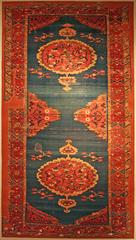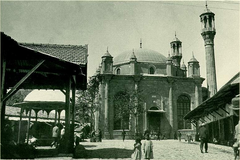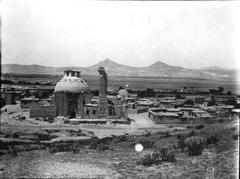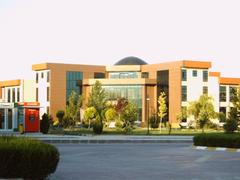Tahir and Zühre Masjid and Türbe: Visiting Hours, Tickets, and Historical Guide – Konya, Turkey
Date: 14/06/2025
Introduction
The Tahir and Zühre Masjid and Türbe in Konya, Turkey, stands as a distinguished monument of 13th-century Anatolian Seljuk architecture and spiritual heritage. Located in Abdülaziz Mahallesi in the Meram district, this site harmoniously blends religious, architectural, and folkloric significance, making it an essential destination for travelers interested in Islamic mysticism, Seljuk art, and Turkish cultural traditions. The masjid and mausoleum are dedicated to the legendary figures Tahir and Zühre, whose story of pure love and spiritual longing is deeply woven into local folklore and Sufi philosophy, complementing Konya’s broader spiritual landscape shaped by Rumi and the Mevlevi Order.
Commissioned by Sahip Ata Fahreddin Ali, a prominent vizier in the Seljuk Sultanate of Rum, the complex epitomizes the Seljuk tradition of integrating places of worship with commemorative türbes (tombs). Architecturally, it features a square prayer hall topped by a brick dome, intricate tile decorations, and a türbe with its own distinctive dome—all executed with the material finesse and decorative artistry characteristic of the period. The site remains an active place of worship and pilgrimage, preserving Konya’s intangible cultural heritage and welcoming visitors interested in history, architecture, and spirituality.
This guide provides detailed information on the historical context, architectural features, restoration efforts, visiting logistics, nearby attractions, and practical tips for experiencing the Tahir and Zühre Masjid and Türbe. For up-to-date details, consult official tourism and heritage resources (source, source, source).
Historical Context
Konya and the Seljuk Era
During the 13th century, Konya flourished as the capital of the Anatolian Seljuk Sultanate, becoming a vibrant center for Islamic scholarship, architecture, and the arts. The construction of religious complexes such as the Tahir and Zühre Masjid and Türbe was part of a wider civic and spiritual development, with local patrons like Sahip Ata Fahreddin Ali commissioning buildings that served both community worship and commemorative functions. Despite political upheavals, Konya’s architectural and spiritual life thrived, leaving a legacy that continues to shape the city’s identity (source).
Patronage and Legacy
Sahip Ata Fahreddin Ali’s contributions to Konya’s urban and spiritual fabric are evident in the enduring presence of neighborhood masjids, medreses, and türbes. By decentralizing worship spaces and commemorating notable figures, these projects reinforced the Seljuk ethos of integrating social, religious, and memorial functions in everyday life.
Architectural Features
Layout and Spatial Organization
The complex consists of three main components:
- Masjid (Prayer Hall): A square-plan structure with a brick dome supported by Turkish triangles (pendentives).
- Türbe (Mausoleum): Adjoining the masjid, the türbe has a rectangular base and its own low brick dome, serving as a symbolic resting place for Tahir and Zühre.
- Medhal (Entrance Vestibule): Connects the main entrance to the masjid and türbe, covered by a barrel vault.
This compact arrangement is typical of neighborhood Seljuk religious complexes, efficiently combining worship and memorialization (source).
Entryways and Circulation
The east façade features a pointed arch portal adorned with blue, turquoise, and black tile mosaics. The medhal provides direct access to the masjid and internal entry to the türbe, maintaining visual and spatial unity throughout the complex (source).
Construction Techniques
Constructed predominantly from fired brick and cut stone, the masjid and türbe display intricate brick patterns, especially in the dome and portal. Turkish triangles transition the square base to the dome, while squinches or pendentives support the türbe’s low dome (source).
Decorative Artistry
The complex is notable for its Seljuk tilework—geometric and floral motifs crafted with mosaic tiles, particularly around the portals and mihrab. The mihrab’s stalactite (muqarnas) hood and the dome’s central medallion, inscribed with kufic calligraphy, exemplify the period’s three-dimensional ornamentation and calligraphic artistry (source).
Lighting
Pointed-arch windows on the main façade allow ample daylight to illuminate the prayer space, enhancing both spiritual ambiance and architectural detailing (source).
Restoration and Preservation
Timeline and Philosophy
- Early preservation: While the original construction date is not precisely known, the masjid has been maintained as a vital religious site since the 13th century (source).
- 1990 Restoration: The General Directorate of Foundations undertook significant stabilization and restoration, focusing on tilework and structural repairs (source).
- 2017–2018 Conservation: Extensive documentation, structural analysis, and restoration were carried out in line with international standards, emphasizing material authenticity and detailed research (source).
Key Challenges
- Environmental damage and previous repairs occasionally compromised original tilework.
- The türbe’s eastern section required reconstruction based on archival documentation; the mihrab’s lower portion is a modern replacement, with original fragments preserved above (source).
Ongoing Measures
- Regular environmental monitoring and preventive conservation protect the structure and decorative elements.
- Community engagement promotes respectful visitation and sustainable heritage management (source).
Visiting Information
Location and Getting There
- Address: Muzaffer Hamit Sokak, Abdülaziz Mahallesi, Meram, Konya, Turkey
- Transport: Reachable by local bus, taxi, or a 20-minute walk from Konya city center.
Visiting Hours
- Open daily from 8:00 or 9:00 AM to 6:00 PM; confirm locally for variations during holidays or religious events.
Tickets and Entry
- Admission is free; donations are welcome to support ongoing maintenance.
Accessibility
- The site is partially accessible for visitors with limited mobility. Some areas have uneven historic flooring and may require assistance.
Guided Tours and Special Events
- Guided tours are offered by local operators specializing in Seljuk heritage; check with Konya tourism offices for schedules.
- Special religious and cultural events may be held during Islamic holidays.
Travel Tips
- Dress modestly (shoulders, legs, and for women, hair covered).
- Remove shoes before entering prayer spaces.
- Visit during morning or late afternoon for optimal lighting.
- Respect ongoing worship and local customs.
Facilities
- Basic amenities are available nearby; the site itself retains a historical character.
Nearby Attractions
- Mevlâna Museum: Mausoleum of Rumi, spiritual heart of Konya.
- Alaeddin Mosque: Major Seljuk-era mosque atop Alaeddin Hill.
- İnce Minaret Medrese and Karatay Medrese: Exemplary Seljuk educational buildings, both within easy walking distance.
Architectural Highlights
| Feature | Description | Materials | Techniques |
|---|---|---|---|
| Masjid Dome | Square base, Turkish triangles, brickwork | Brick, tile | Turkish triangles, tiles |
| Türbe Dome | Rectangular base, low dome | Brick | Squinches/pendentives |
| Mihrab | Stalactite hood, tile and stucco | Plaster, tile | Muqarnas, tile inlay |
| Portal | Pointed arch, tile mosaics | Brick, tile | Mosaic tilework |
| Lighting | Pointed-arch windows | Brick, glass | Strategic placement |
Cultural and Spiritual Importance
The Tahir and Zühre Masjid and Türbe embodies the enduring values of love, devotion, and community central to Turkish folklore and Sufi tradition. The tale of Tahir and Zühre, often likened to Romeo and Juliet, conveys a message of spiritual longing and union with the Divine, enriching the site’s atmosphere. Active as a neighborhood masjid, it hosts daily prayers, religious gatherings, and local charitable events, reinforcing its role in Konya’s living heritage (source).
Etiquette and Visitor Guidance
- Dress modestly; cover arms, legs, and women should cover hair.
- Remove shoes before entering prayer areas.
- Photography is generally permitted, but avoid flash and disruption during worship.
- Respect silence, especially during prayer times.
- Learn a few basic Turkish greetings to enhance your visit.
Frequently Asked Questions (FAQ)
Q: What are the opening hours?
A: Typically 8:00 or 9:00 AM to 6:00 PM daily. Confirm locally for updates.
Q: Is there an entrance fee?
A: No, admission is free.
Q: Are guided tours available?
A: Yes, through local cultural and tourism agencies.
Q: Is the site accessible for wheelchair users?
A: Partial accessibility; some areas may present challenges due to historic flooring.
Q: Can non-Muslims enter?
A: Yes, outside prayer times, with respectful conduct and proper attire.
Q: Can I take photographs?
A: Yes, but please be discreet and avoid using flash inside.
Visual Gallery
Further Resources and Official Links
- Official Konya Tourism Website
- Tahir and Zühre Masjid – Gokonya.com
- Restoration and Conservation Project
- Gençliğin Sesi: Tahir ile Zühre Türbesi
- 9Lib: Seljuk Neighborhood Masjids
Conclusion
The Tahir and Zühre Masjid and Türbe is a vital piece of Konya’s Seljuk heritage, offering visitors a harmonious blend of architectural beauty, spiritual depth, and living tradition. Through ongoing restoration, community engagement, and accessible visitor information, the site remains a testament to centuries of devotion and artistry. Whether you seek quiet reflection, historical exploration, or inspiration from timeless tales of love and faith, the Tahir and Zühre Masjid and Türbe is an essential stop on any Konya itinerary.
For further guidance and the latest updates on Konya’s historical sites, download the Audiala app or explore official tourism platforms. Respectful and informed visitation helps ensure this Seljuk treasure continues to inspire for generations to come (source, source).
Sources
- https://9lib.net/article/z%C3%BChre-mescidi-y%C3%BCzy%C4%B1l-anadolu-sel%C3%A7uklu-d%C3%B6nemi-mahalle-mescitl.dzxowndz
- https://gokonya.com/en/tahir-and-zuhre-mosque
- https://gencliginsesi.com/tahir-ile-zuhre-turbesi/
- https://artibirproje.com/en/projects/architectural-conservation-documentation-restitution-and-restoration-project-of-tahir-ile-zuhre-masjid/
- https://www.konya.bel.tr/en



